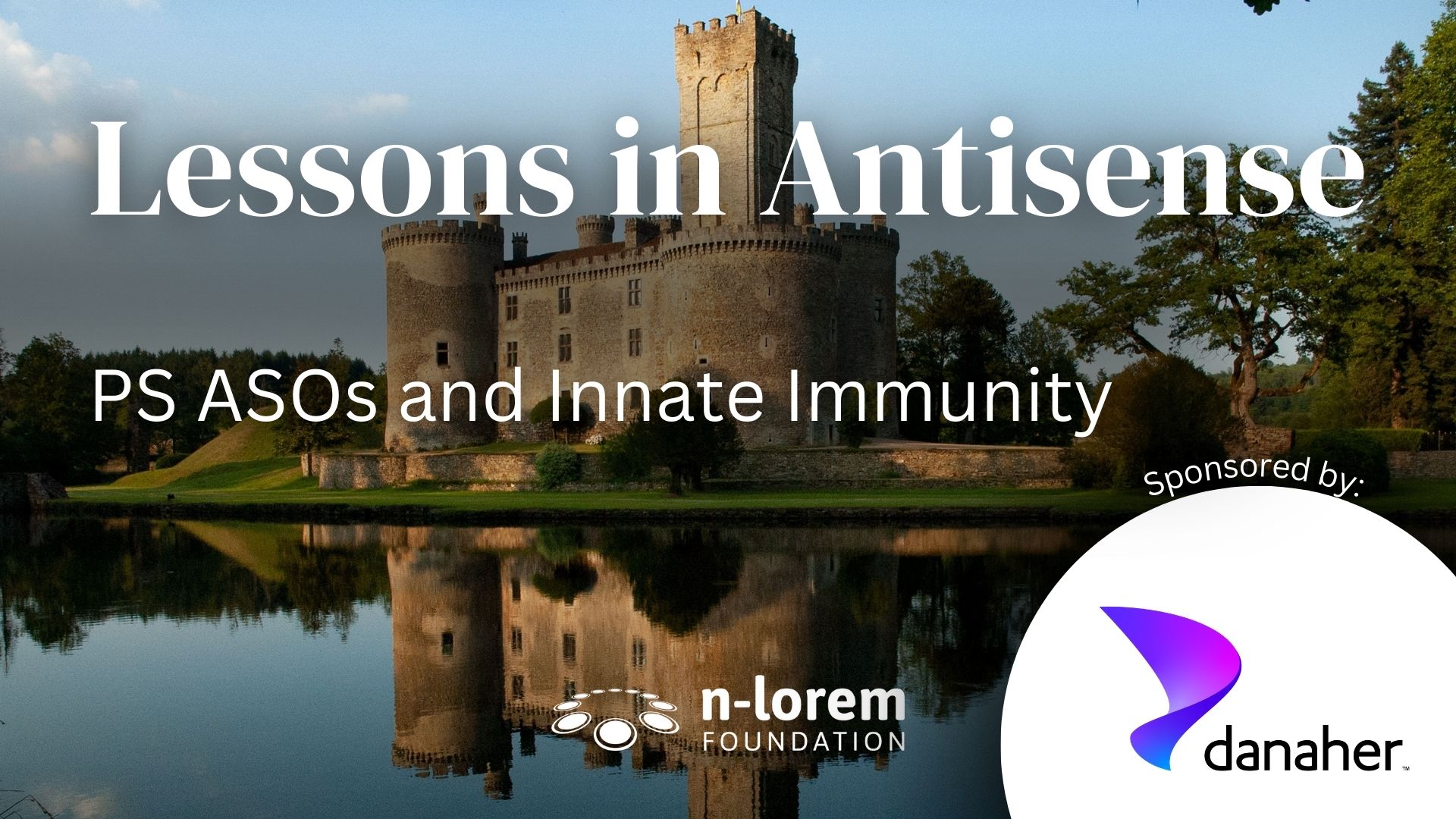Lessons in Antisense
Lesson 13 – PS ASOs and Innate Immunity
July 14, 2025 by Dr. Stan Crooke

Introduction
The innate immune system is a primordial host defense system present in all mammalian cells. Its primary role is to identify intracellular threats and neutralize them, and it is comprised of sensors, and signaling and effector systems. The sensors that are relevant to PS ASOs are nucleic acid sensors, including pattern recognition receptors like toll-like receptors (TLRs), retinoic acid-inducible gene I (RIG-I), melanoma differentiation-associated protein 5 (MDA5), cyclic GAMP synthase (cGAS), stimulator of interferon genes (STING) and others. Each sensor recognizes different forms of nucleic acids; TLR9 single stranded (ss) DNA, TLR3 double stranded (ds) DNA, TLR7/8 ssRNA, RIG-I ssRNA in cytoplasm, MDA5 dsRNA, STING and cGAS cytosolic dsRNA. TLRs signal through NF-kB to induce cytokines and interferon regulatory factors (IRFs) to induce interferons, while other receptors typically induce interferons.
Since mammalian DNA has methylated cytosine-phosphate-guanine (CpG) motifs, while viral and bacterial DNAs have unmethylated CpGs, TLR9 is acutely sensitive to unmethylated CpGs in ssDNA. Other structural features of ss and ds RNA and ds DNA are identified by other sensors. Though the precise triggers and pathways are not understood, it is clear that, on occasion, activating the innate immune system can lead to activation of the complement system, the kallikrein/bradykinin pathway, the angiotensinogen pathway, and adaptive immunity with potentially catastrophic consequences including vascular collapse.
Recently, significant interest has focused on the mechanisms by which acute inflammatory responses are actively terminated. Failure to terminate acute inflammatory responses can lead to chronic systemic inflammation (CSI), which is thought to play a causal role in 50% of deaths in developed economies.
Oligo-and polynucleotide stimulation of innate immunity
Since work in the 1970s had shown that Poly IC and other polynucleotide could induce high, sometimes fatal, levels of interferon, it was no surprise that PS oligodeoxynucleotides (PS ODNs) were highly pro-inflammatory. As mentioned in an earlier lesson, in non-human primates, PS ODNs caused fatal induction of innate immune activation coupled to complement activation. In humans, severe injection site reactions after subcutaneous injections and fever and chills after IV or subcutaneous administration were encountered. Though the primary purpose of the medicinal chemistry focus on the 2’ position was to increase affinity for target RNAs and thus potency, an important, unpredicted benefit of 2’-MOE substitution was a dramatic reduction in immune stimulation, which when coupled to the enhanced potency, meant that PS ASOs could be developed therapeutically. However, the mechanisms underlying the immune stimulation of PS ASOs and those responsible for the significant reduction in immune activation observed with 2’-MOE substitutions were largely unknown. Studies in a TLR9 knockout mouse suggested that TLR9 might be involved, but the mechanism remained a mystery. The mouse immune system is significantly different from primates, so conclusions were limited. However, Sebastian Burel of Ionis had also shown in human peripheral blood monocytes (PBMCs) and BJAB cells, that TLR9 was activated by 2’-modified PS ASOs. As a result, our work focused on TLR9, but we felt that we needed to exclude other sensors for nucleic acids, such as TLR3 and STING.
PS ASOs activate innate immunity via interactions with TLR9
To better understand the molecular mechanisms of innate immune stimulation and termination, we used two cell systems, HEK293 cells stably overexpressing TLR9 and BJAB cells. To answer the question of whether TLR9 is the sole sensor for PS ASOs, we reduced TLR9 or two downstream effectors, MyD88 and UNC93B1. All the data were consistent with TLR9 being the major sensor of PS ASOs, but none of the treatments ablated innate activation, and the effects of reducing each target were a bit different in BJABs vs HEK293s. Therefore, I don’t think that we can absolutely exclude other sensors and pathways, but understanding the interactions of PS ASOs is certainly critical.
Not only can PS ASOs range from full to partial agonists; they can also be potent competitive antagonists, and the kinetics of immune activation vary, with full agonists generally resulting in more rapid induction. Some non-immune stimulatory PS ASOs can, in fact, act as true competitive antagonists for CpG and non-CpG-containing innate stimulatory PS ASOs. Particularly given the fact that TLR9 monomers have two sites for PS ASOs and TLR9s form homodimers when activated, the most obvious explanation for the variation in agonist activity were different binding sites or different interactions at the same sites for various PS ASOs. Although, we have studied that as thoroughly as possible, given current technology, and cannot explain the differences in agonist activity with TLR9. We then wondered whether differences in cell uptake and sub-cellular distribution could explain the variable responses since TLR9 is active in late endosomes (LEs) and PS ASOs accumulate in LEs. We showed that, indeed, if we altered entry into LEs of PS ASOs, innate activation was reduced, but there was no variation in LE accumulation of PS ASO that could explain the differences.
Since we had shown that PS ASOs bind to many proteins, both extra- and intracellular, we studied the effects of various proteins on innate activation. Human serum albumin (HSA) significantly reduced innate stimulation by PS ASOs; we suspect by reducing the free PS ASO concentration. In contrast, histidine-rich glycoprotein (HSG), S100A8, and HMGB1 bind to PS ASOs, colocalize with MyD88, PS ASOs and TLR9 in LEs and enhance immune activation. However, binding to these proteins did not explain the differences between different PS ASO sequences.
Structure-activity relationship of PS ASO-induced innate immune activation
In short, the structure-activity relationship (SAR) of PS ASO induction of innate immunity is complex and may vary from cell type to cell type. PS content and location are important. PS ASOs that have less than 10 PSs are unlikely to bind to TLR9 or activate innate immunity. On the other hand, some PS/PO sequences can be more innate stimulatory than full PS ASOs. CpG number and placement are important and, basically, the more CpG, the worse the immune stimulation. The effects of CpGs are position influenced, but once again, complex. As a general rule, more hydrophobic 2’-modifications such as cEts are more immune stimulatory, but once again, there are notable exceptions that are position and sequence dependent. Following on from our work on cytotoxicity, we evaluated site-selective medications with mesyl-phosphonate or methoxy reduced innate stimulation in some cases, but in others had no effect. Nor did any of the SAR correlate with affinity to TLR9. Obviously, there are many factors, including binding to various proteins that may account for the difficult to interpret SAR.
We subsequently showed that some non-immune stimulatory PS ASOs can cooperatively activate TLR9 in the presence of innate stimulatory ASOs, and that such ASOs likely bind to sites in TLR9 that differ from those that are directly innate stimulatory. In effect, such PS ASOs can be considered allosteric TLR9 binders while antagonistic PS ASOs likely compete for the same sites at innate activating PS ASOs.
Conclusions
We know that PS ASOs can potentially activate innate immunity via binding to TLR9 and that we should avoid CpGs. Beyond that, we know that both extracellular and intracellular proteins that bind PS ASOs can alter innate immune activation. However, the structure-activity relationship of innate immune activation by PS ASOs is complex with full and partial agonists, competitive antagonists, and non-immune active PS ASOs that can enhance the immune activation of other PS ASOs. Further, unlike cytotoxicity, we have identified no simple pattern of substitutions that can reduce the potential to induce the innate immune system.

We cannot do
this alone
Together we are changing the world—
one patient at a time
We hope that you join us on this journey to discover, develop and provide individualized antisense medicines for free for life for nano-rare patients. The ultimate personalized medicine approach – for free, for life.
Follow us on social for updates on our latest efforts


